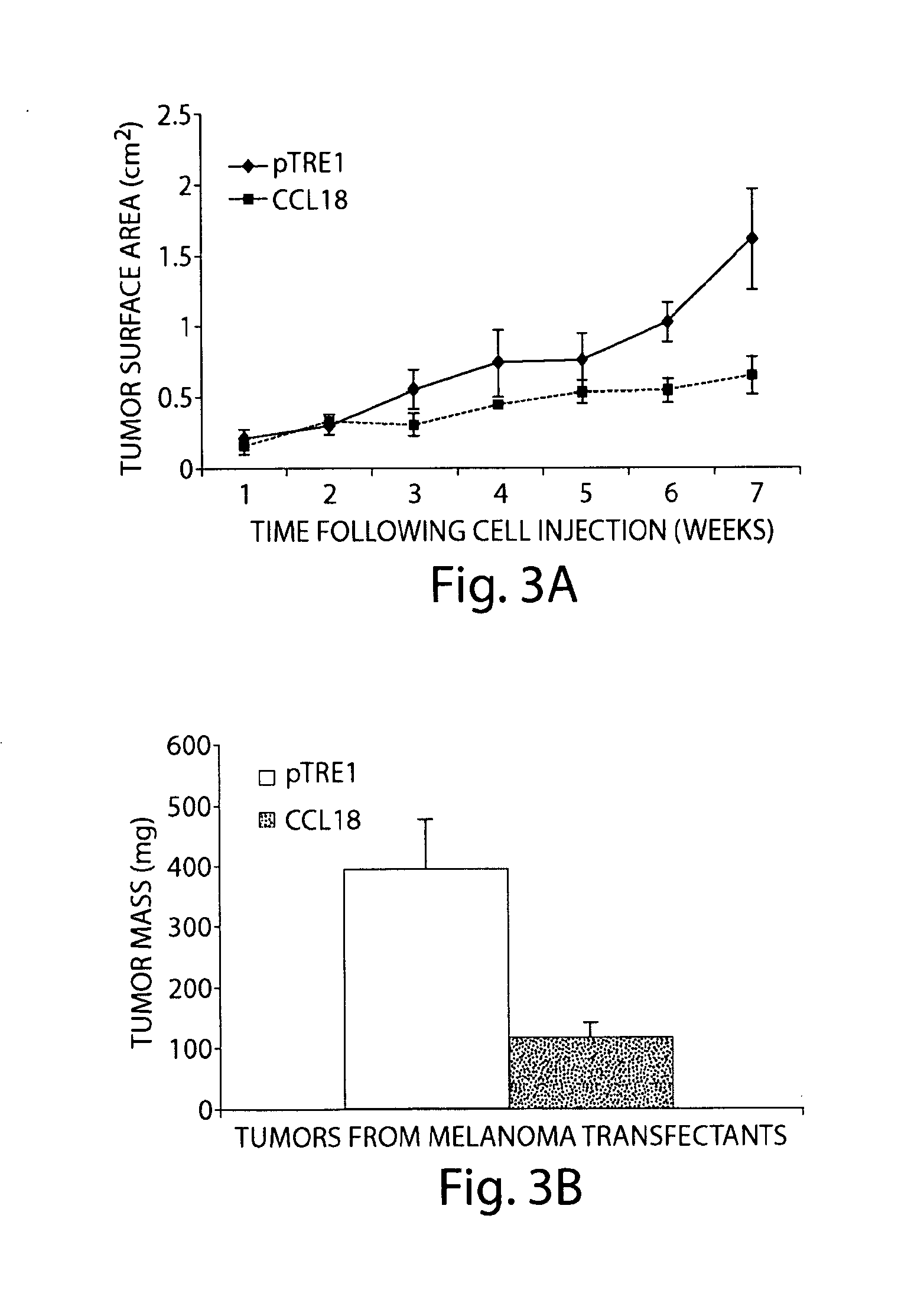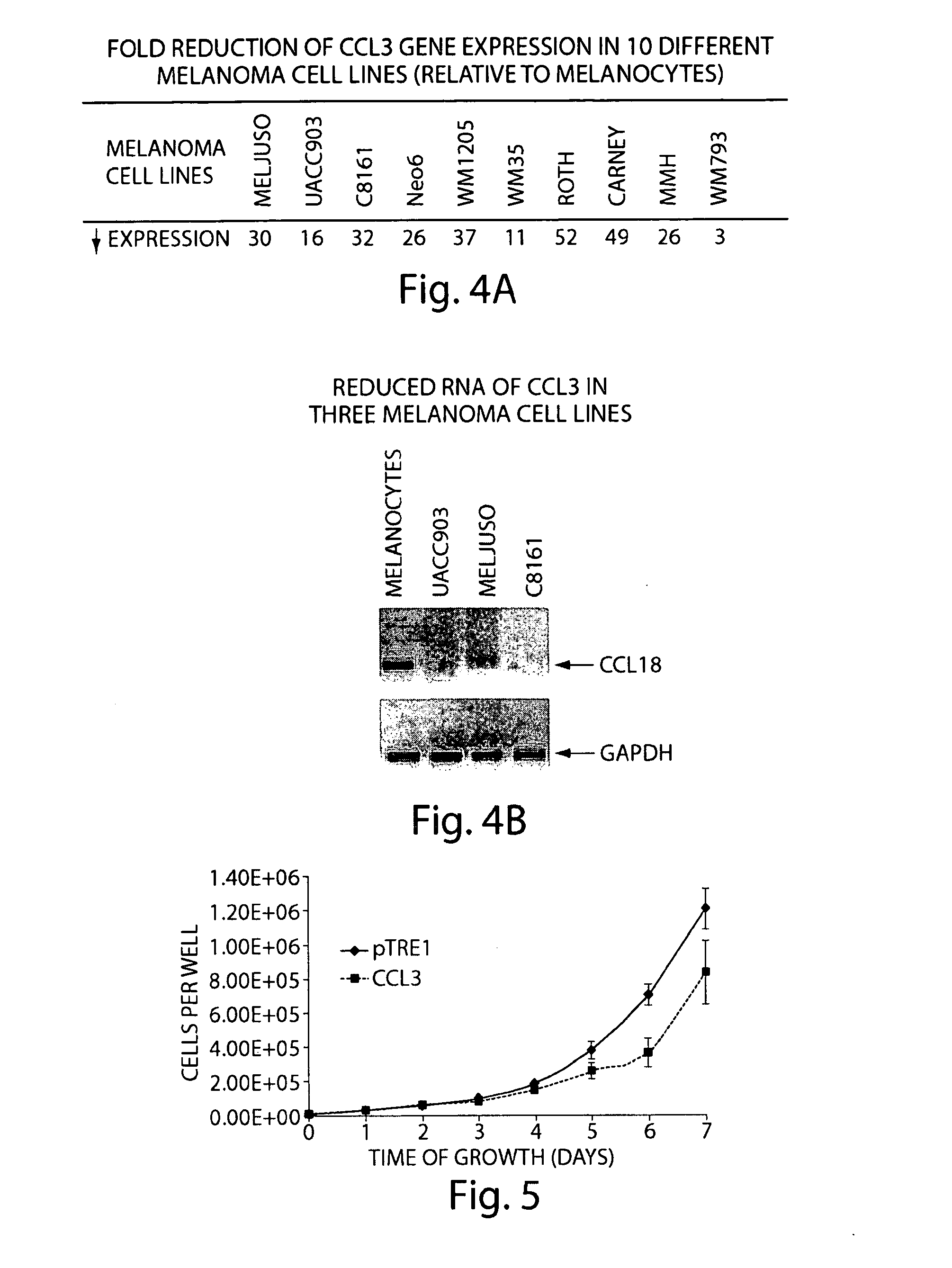Ccl18 and ccl3 methods and compositions for detecting and treating cancer
a technology of ccl18 and ccl3, applied in the field of ccl18 and ccl3 methods and compositions for detecting and treating cancer, can solve the problems of insufficient definitive evidence, no current therapies that have statistically significant survival benefits, and difficult diagnosis of melanoma, etc., and achieves suppressing tumor growth, reducing cell growth, and reducing expression of ccl18 and ccl3
- Summary
- Abstract
- Description
- Claims
- Application Information
AI Technical Summary
Benefits of technology
Problems solved by technology
Method used
Image
Examples
example 1
CCL18 as a Tumor Suppressor for Melanoma
[0118]A tumor suppressor is characterized by a gene or gene product whose loss or reduction of expression causes or promotes abnormal cell growth or proliferation. It has been demonstrated that expression of the chemokine CCL18 is reduced in melanoma cells, relative to benign melanocytes. Furthermore, it is shown that exposure of CCL18 to melanoma cells reduces growth in vitro and suppresses tumor growth in vivo.
Reduced CCL18 Expression in Melanoma Cell Lines
[0119]Studies were conducted to examine relative expression levels of CCL18 in ten melanoma cell lines, namely, MelJuSo, UACC903, C8161, Neo6, WM1205, WM35, ROTH, CARNEY, MMH and WM793, as compared to that of normal human melanocytes.
[0120]To determine the relative expression levels of CCL18 in these cell lines, cellular RNA levels were measured using a gene array-based system. Samples were harvested from each of ten melanoma cell lines and from primary human melanocytes and analyzed for d...
example 2
CCL3 as a Tumor Suppressor for Melanoma
[0127]A tumor suppressor is characterized by a gene or gene product whose loss or reduction of expression causes or promotes abnormal cell growth or proliferation. It has been demonstrated that expression of the chemokine CCL3 is reduced in melanoma cells, relative to benign melanocytes. Furthermore, it is shown that exposure of CCL3 to melanoma cells reduces growth in vitro and suppresses tumor growth in vivo.
Reduced CCL3 Expression in Melanoma Cell Lines
[0128]Studies were conducted to examine relative expression levels of CCL3 in ten melanoma cell lines, namely, MelJuSo, UACC903, C8161, Neo6, WM1205, WM35, ROTH, CARNEY, MMH and WM793, as compared to that of normal human melanocytes.
[0129]To determine the relative expression levels of CCL3 in these cell lines, cellular RNA levels were measured using a gene array-based system. Samples were harvested from each of ten melanoma cell lines and from primary human melanocytes and analyzed for differe...
example 3
Gene Upregulation in CCL3- and CCL18-Expressing Cells
[0136]Changes in expression of a number of specific genes in CCL3-expressing MelJuSo cells relative to CCL3-negative cells and in CCL18-expressing MelJuSo cells relative to CCL18-negative cells was determined. Genes upregulated CCL3 expressing MelJuSo cells relative to CCL3-negative MelJuSo cells are shown in Table 1. Genes upregulated specifically in CCL18 expressing MelJuSo cells (PARC-expressing MelJuSo cells) relative to CCL18-negative MelJuSo cells are shown in Table 2. In each of Tables 1 and 2, column E (bold) refers to the fold-upregulation relative to non-expressing cells and column I (bold) provides the gene symbol. Columns C and F represent “present / absent call” and “increased / decreased”, respectively. Although not wishing to be bound by a particular theory, the upregulation of these genes may be part of the mechanism by which CCL3 and CCL18 suppress tumorigenesis.
[0137]The gene expression data presented in Tables 1 and...
PUM
| Property | Measurement | Unit |
|---|---|---|
| thickness | aaaaa | aaaaa |
| concentrations | aaaaa | aaaaa |
| CT | aaaaa | aaaaa |
Abstract
Description
Claims
Application Information
 Login to View More
Login to View More - R&D
- Intellectual Property
- Life Sciences
- Materials
- Tech Scout
- Unparalleled Data Quality
- Higher Quality Content
- 60% Fewer Hallucinations
Browse by: Latest US Patents, China's latest patents, Technical Efficacy Thesaurus, Application Domain, Technology Topic, Popular Technical Reports.
© 2025 PatSnap. All rights reserved.Legal|Privacy policy|Modern Slavery Act Transparency Statement|Sitemap|About US| Contact US: help@patsnap.com



